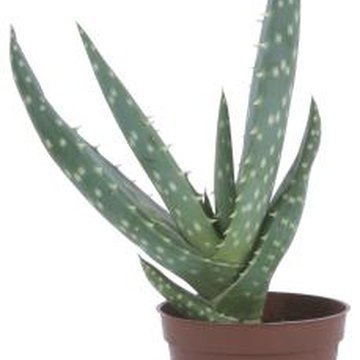
A common houseplant, aloe vera treats skin ailments naturally.
Many households have an aloe vera plant (aloe barbadensis) among the collection of plants. Aloe vera grows outdoors in U.S. Department of Agriculture plant hardiness zone 9 and above; however, the plant is often grown indoors. Aloe vera gel has been used for centuries by many cultures to treat common skin ailments, such as sunburns. A member of the lily family, aloe vera leaves can be cut for use as an all-natural skin remedy.
About Aloe

The perennial succulent, aloe vera, grows to a height of 4 feet with leaves reaching 3 feet long. The thick, spear-shaped leaves taper at the ends and often have spiked edges. These green, speckled leaves contain gel that can be spread on the skin to treat skin irritation. This plant requires loose, well-drained soil or a potting mix designed for cacti, and a large drain hole in the pot. If grown outdoors, aloe vera prefers full sun and well-drained soil. Indoors and outdoors, the soil needs to dry out before soaking with water.
Proper Cutting

Taking aloe vera cuttings requires few tools. Although the leaves can be snapped off with your hands, use a sharp knife to ensure the leaf edge does not tear and the plant remains appealing to the eye. If you wish to start a new aloe plant, cut one sprout, or offset, close to the base when the offset is about 2 inches long. Allow the plant to scab over before replanting it in fresh potting mix.
Topical Uses

Squeeze the gel out of the leaf and apply topically to treat skin irritation such as minor burns, sunburn, small cuts and scrapes. Aloe vera gel contains chemicals that relieve pain and inflammation, as well as encourage skin repair and growth. As with all topical treatments, discontinue use if a rash appears. People with latex allergies may wish to avoid aloe vera. Consult a health professional if you are unsure whether aloe vera gel is the proper herbal treatment for you.
Other Uses

Cultures around the world use the aloe vera plant to treat ailments not related to the skin. Aloe latex, a yellow substance found close to the leaf skin, is a powerful laxative. Taken orally, parts of the aloe plant treat diabetes and lower cholesterol. However, if taken in large doses, aloe vera can cause stomach cramps or kidney damage. In addition, a high tolerance for the laxative can develop quickly. Consult a health care professional before taking aloe vera orally.
No comments:
Post a Comment